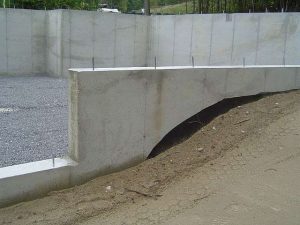Pouring Concrete Foundations in Winter is Tricky Business but is Doable if the Right Precautions are Taken
By Mark J. Donovan
|
|
For one reason or another a builder or homeowner may find him or herself pouring a foundation in winter. Pouring concrete foundations in winter can be a risky venture. If not done without taking the necessary precautions, or if the temperature is just simply too cold, there is a risk that the concrete may freeze prior to it curing.
If this happens the foundation walls could be severely and permanently compromised in strength. In addition, the concrete may experience cracking or spalling, where the concrete literally splits, flakes or show signs of pitting. |
So why does the concrete run the risk of experiencing these types of problems when pouring foundations in winter?
The answer to this question is in the curing process itself of concrete. Concrete both needs and produces heat to properly cure. If the ambient air temperature is so cold that it too rapidly draws the heat out of the concrete while it is curing, the concrete may not set up properly and the water in the concrete could actually freeze. As a result, the foundation walls could be dramatically weakened and possibly exhibit cracks and spalling.
| For maximum strength and reduced risk of cracks and spalling, foundation contractors prefer to pour concrete when the temperature is expected to be above 40 degrees Fahrenheit for 3 consecutive days.
Consequently they usually pay very close attention to the weather forecasts during the winter months. In extreme northern climates they may even shut down operations during the dead of winter. |
 |
In situations where pouring the foundation walls in temperatures below 40 degrees Fahrenheit is a necessity, foundation contractors will include an anti-freeze admixture in the concrete to help prevent the water from freezing and thus enable the concrete to cure properly.
Years ago when I built my vacation home in central New Hampshire we were forced into pouring foundation walls in winter. It was January and the temperatures fluctuated between 20 and 40 degrees Fahrenheit for days. Finally we had a window of warmer weather, the January thaw if you will, and poured the foundation walls. In addition to waiting for mildly warmer weather, our foundation contractor also took additional precautions including mixing in some calcium chloride into the concrete, and insulating the walls with hay after pouring the concrete to help keep the heat in, slow the curing process and prevent freezing.
| He also asked the concrete plant to heat the concrete prior to delivering it to our site. Fortunately our foundation is still crack free, but suffice it to say, it was a nervous phase during the construction of our home.
In regards to the use of calcium chloride in concrete, our foundation contractor used about a 2:100 ratio of calcium chloride to concrete. The calcium chloride lowers the freezing temperature of water and thus helps to prevent the water in the concrete from freezing, which enables the concrete to have sufficient time to cure properly. |

Use one of these home remodeling checklists and save time and money on your home building project. |
In addition to the precautions already mentioned when pouring foundations in winter, foundation contractors can also ask the concrete plant to include air-entraining admixtures in the concrete mixture. Air-entraining admixtures help by trapping tiny air bubbles into the concrete mix so that any freezing water in the concrete has a place to go without damaging the foundation walls. The foundation contractor can also ask the concrete plant to include more cement in the concrete mixture to help the mix more quickly gain strength to handle the freezing temperatures. Adding more cement to the mixture, however ads more cost to the cement.
To conclude, pouring foundations in winter is possible as long as the right precautions are taken and the temperatures are not so extremely cold that the admixtures simply can’t do their job. Make sure when interviewing foundation contractors you ask them the techniques they normally employ when pouring foundations in winter and see if they match any of the above recommendations.
For more help on building a home addition, see HomeAdditionPlus.com’s Home Addition Bid Sheets. Our Home Addition Bid Sheets provide you with the knowledge and information on how to plan a home building project, and what to look for when hiring contractors. They also include detailed cost breakdown tables and spreadsheets for estimating your own new home construction building costs.
Related Information
Free Home Addition Price Quotes with No Obligation!
Fill out our 3-5 minute quick and easy form, and receive a free price quote on a house addition from one of our prescreened and licensed home addition contractors. This process is free and there is no obligation to continue once you receive your house addition price estimate.
